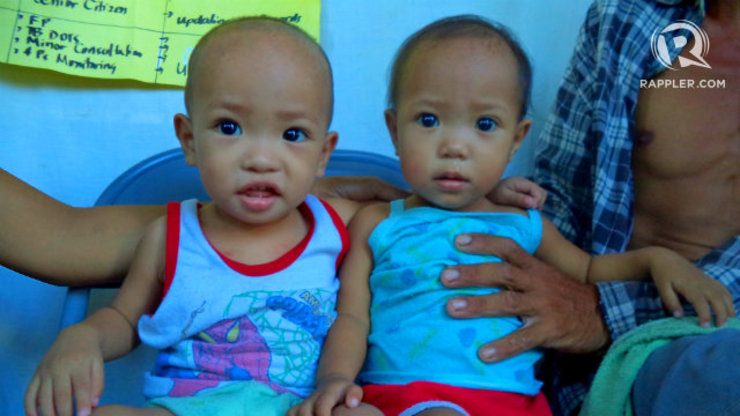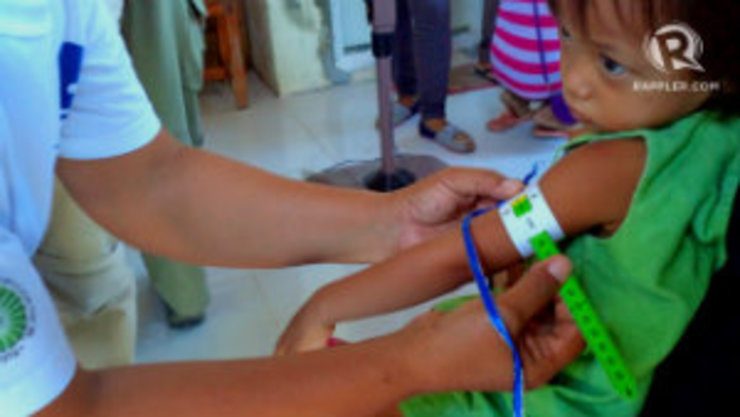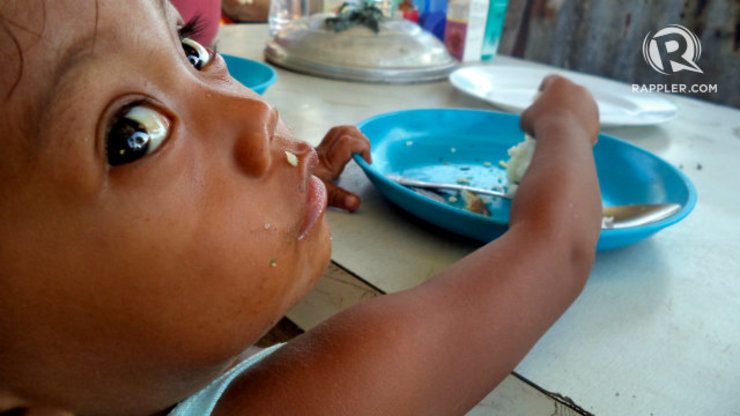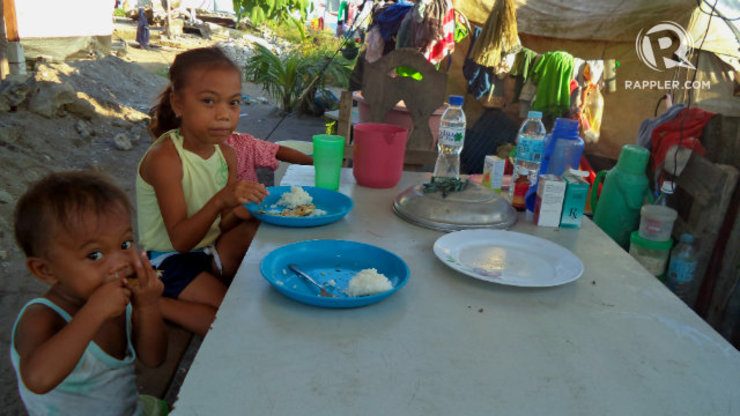SUMMARY
This is AI generated summarization, which may have errors. For context, always refer to the full article.

TACLOBAN, Philippines — Jake and Jesabel are twins. They were both malnourished.
J and J were already malnourished even before Super Typhoon Yolanda (Haiyan) devastated Eastern Visayas. The twins were born to a poor family in San Jose, Tacloban. Their parents tilled soil which was not even theirs.
They lived on small plates of rice and salt. If there was extra money, they headed over to the karinderya (canteen).
After Yolanda, J and J’s parents lost their livelihood. The father then traded his sickle for pedals, while the mother stayed at home with the twins.
Every day, the father rises early and stays out late only to earn P250, if lucky. Every day, he worries whether he can afford the pedicab’s P50 rental fee.
“Sapat lang kita pambili isang kilong bigas,” the father said. (Earnings are just enough to buy one kilo of rice.)
Life has always been tough for J and J’s family. Yolanda made it tougher.
The 2013 National Nutrition Survey (NNS) revealed that in Eastern Visayas, the prevalence of both underweight and stunted children under 5 years old was higher than the national average. In fact, it had the 5th highest stunting prevalence across all regions.
This was before Yolanda.
After the storm, what happened to children like J and J? If they were barely eating then, how are they doing now?
After the storm
After disasters, one might anticipate higher malnutrition rates. However, a survey conducted 3-4 months after Yolanda, showed otherwise. (READ: Nation at risk)
The country’s Nutrition Cluster conducted a SMART (Standardized Monitoring and Assessment of Relief and Transitions) survey among Yolanda-affected areas in March 2014. It reported a 4.1% moderate acute malnutrition rate – which is lower than the reported rates for Regions VI, VII, and VIII based on the 2013 NNS.
These regions reported rates somewhere between 7-8%.
“Rates went lower after Yolanda. Why? It’s important to note that the SMART survey used a different methodology,” said Judith Wolff, nutrition program manager of Action Against Hunger (ACF), a humanitarian organization working in Yolanda-affected areas.
After Yolanda, many families like J and J’s lost livelihoods  – mostly farmers and fishers – which ultimately affected their access to proper nutrition. Several non-governmental organizations (NGOs), however, tried to address such problems through interventions such as feeding, sanitation and health programs.
– mostly farmers and fishers – which ultimately affected their access to proper nutrition. Several non-governmental organizations (NGOs), however, tried to address such problems through interventions such as feeding, sanitation and health programs.
“The SMART survey was also conducted around March, a time when there were many interventions being done,” Wolff added. This might explain why the two surveys showed ironic results before and after Yolanda.
Despite the SMART survey results, Dr Jaime Opinion of the Tacloban City Health Office clarified that malnutrition should still receive ample attention. “After Yolanda, malnutrition definitely went up,” said Opinion. “This is because many families have difficulties in accessing nutritious food.”
Opinion stressed that schoolchildren, next to senior citizens, concerned him the most after Yolanda. “We have a population of 30,000 preschoolers.”
He added that the city’s assessment of children’s nutritional status is ongoing and will be available at the end of the year. “NGOs provide feeding programs, our focus is on advocacy. We teach families about proper nutrition,” said Maria Lumen of the City Health Office.
Yolanda also affected health centers, leaving health workers without equipment. “Weighing scales were destroyed,” said Lumen.
“International organizations donated replacements and taught barangay health stations how to use MUAC tapes,” which are used for identifying severely malnourished children.
School feeding

Since 2011, the Department of Social Welfare and Development (DSWD) has been conducting 120-day Supplementary Feeding Programs (SFP) across daycare centers nationwide.
For the school year 2014-2015, it has covered more than half a million children as of October, DSWD reported.
But the program has not yet begun in Tacloban, according to Lumen. The Tacloban City Social Welfare and Development Office (CSWDO), however, clarified that the SFP will begin by the second week of November.
“The reason behind this is because there are a lot of NGOs doing blanket feeding programs after Yolanda,” Dr Gloria Fabregas, acting Tacloban CSWDO head, told Rappler in a phone interview. “We didn’t want to interrupt or duplicate these programs.”
Fabregras added that the program’s funds were released in September 2014, while necessary preparations began in October – including weighing children, making menus, and finalizing strategies.
“Besides that, supplemental feeding is not intended because of Yolanda. It will be a continuing program,” she stressed.
In Eastern Samar, some barangays also claimed that the SFP has not yet begun.
“‘Di pa nakakarating dito ang feeding program ng DSWD,” the sole teacher of Barangay Sta Fe said. (DSWD’s feeding program hasn’t reached us yet.)
Meanwhile, in Barangay Camcuevas, SFP only began on November 3, according to the Parent-Teacher Association of the Camcueves Elementary School.
Health advocates, however, reminded parents not to depend on SFPs alone. Advocates suggest that the current SFP conducted by DSWD and DepEd may still be improved in terms of nutritional value.
These meals are only supplementary, hence parents are obliged to provide their children’s main nutritional needs.
Malnourished, now what?

While children’s low weight may have been affected by Yolanda, health experts clarified that chronic malnutrition or stunting – being too short for one’s age – is different.
“Stunting, you can’t just give a pill and cure it,” said Wolff. “This has nothing to do with Yolanda, this should have been addressed earlier. During the child’s first 1,000 days.”
The first two years of life is critical for both physical and mental growth.
Wolff believes that stunting is not only a health problem, but also a “development issue.” She hopes that the Philippine Integrated Management of Acute Malnutrition (PIMAM) will soon be implemented nationwide.
Once implemented, a stronger community-based management of acute malnutrition will be institutionalized – conducting therapeutic programs in and outside health centers, with the participation of barangay health workers (BHWs).
As of now, PIMAM is only being implemented in certain parts of Mindanao, as led by organizations like ACF, Save the Children, Unicef, and MSF. Its guidelines are still being reviewed by the Department of Health.
“Why isn’t it implemented yet? Problem is with logistics and human resources,” said Dr Martin Parreño, a health expert. “If the government will take over PIMAM, it will have to buy supplies directly.” He asked whether local government units will have the capacity to do it on their own, since health services are devolved. “Also, are there enough BHWs and Barangay Nutrition Scholars (BNS)?”
Today the weights of J and J are normal after they underwent 3 months of therapeutic feeding under ACF. But not all children are reached by NGOs.
Jake and Jesabel are fine now; in the coming months, however, it is still uncertain whether the twins will still be all right. – Rappler.com
For Rappler’s full coverage of the 1st anniversary of Super Typhoon Yolanda (Haiyan), go to this page.
Add a comment
How does this make you feel?
There are no comments yet. Add your comment to start the conversation.